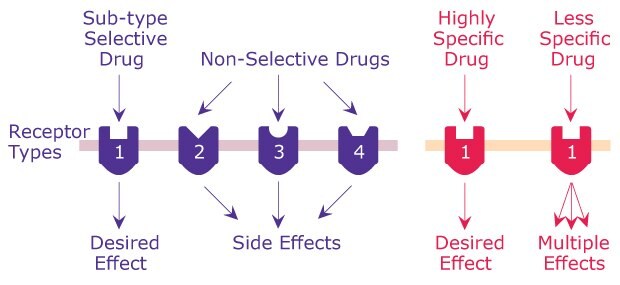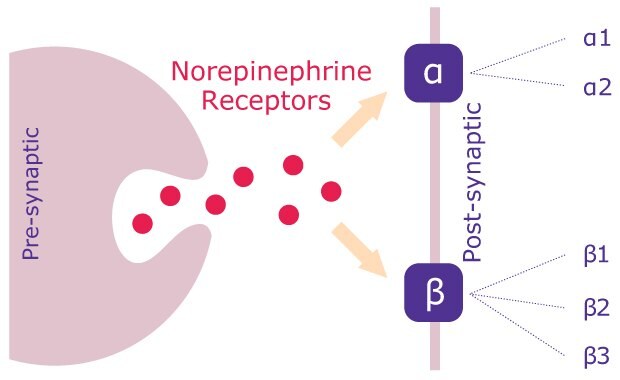Drug Activity and Drug Specificity
When researching drug candidates, it is critical to understand the drug activity and specificity. This includes researching its affinity, intrinsic activity or efficacy, selectivity, and specificity. Keep reading to learn more about the differences in these drug attributes, such as the difference between selective and nonselective antagonists.
Read more about
Affinity vs Intrinsic Activity (Efficacy)
The difference between drug affinity and the intrinsic activity of a drug is:
- Affinity describes the interaction, whether strong or weak, between a drug and the receptor. Higher affinity results in tighter binding.
- Intrinsic activity, also known as efficacy, describes the ultimate effectiveness of a drug molecule.
A drug may have a high affinity for a receptor and bind maximally even at relatively low concentrations, yet it may produce only a weak physiological or pharmacological response. Such drugs have high affinity but low efficacy. Two agents that interact with equivalent sets of receptors may not produce equal degrees of effect even if they are both administered in maximally effective doses. The agents differ in their intrinsic activities, and the one producing the greater maximum effect is said to have greater intrinsic activity.
Years of modeling ligand-receptor pharmacokinetics have shown that agonist or antagonist binding does not equate with the functional, physiological, or pharmacological response. Although potency, which depends on affinity, and intrinsic activity are closely linked, they may be influenced by variations in reaction time or efficiency, the ability of the drug to reach the target site, metabolic disposal rate, etc.
The EC50 value is a measure of the pharmacological response of the drug because it is proportional to both affinity and efficacy. Since experimental conditions can affect ligand binding kinetics and organismal response, it is not surprising that all drug performance measures, like affinity, efficacy, and EC50, are highly sensitive to assay variations.
Drug Selectivity vs Specificity
To be an effective drug or drug candidate, a compound has to offer both selectivity and specificity (Figure 1).

Figure 1.Selectivity vs specificity of drugs.
Selectivity
Selectivity refers to a drug’s ability to preferentially produce a particular effect. It is related to the structural specificity of drug binding to a specific type of receptor. For example, the beta-blocker propranolol binds equally well to both β1- and β2-adrenoceptors, whereas beta-blockers metoprolol or atenolol bind selectively only to β1-adrenoceptors. Another common example is salbutamol, which is used to treat asthma. It binds selectively to β2-adrenoceptors and its selectivity is further enhanced by administering it directly to the lung tissue through inhalation.
Specificity
In comparison, high specificity indicates that a drug’s action results in only a relatively narrow set of cellular responses or downstream signaling paths. The specificity of a drug usually relates to the number of different effects a drug may elicit. If a drug has only one effect, then it is considered to be specific. It also relates to the number of targets it could interact with or the number of cell populations it will affect. For example, yohimbine is used therapeutically as an α2-adrenoceptor blocker, but at higher concentrations, it can also block 5-HT receptors, α1-adrenoceptors, monoamine oxidase, and cholinesterase activity. Hence, it is not considered a very specific drug. On the other hand, salbutamol affects β2 receptors in the lung and is considered a specific drug.
Selective vs Nonselective Antagonists
As the vast majority of drugs act as receptor antagonists, understanding their selectivity (selective or nonselective) is important. Think of ligand-receptor interactions in terms of achieving a single desirable pharmacological response. Centuries of drug design and manufacturing have demonstrated that only very few drugs have one specific pharmacological effect.
The biological variation seen in macromolecular structure and environmental factors affecting ligand-receptor binding kinetics makes it likely that any drug, no matter how carefully designed, will bind under some conditions to multiple targets. Even if a drug was designed to bind to only one receptor, that receptor could be expressed in multiple cell types in an organism, and consequently exhibit different downstream signaling effects. Thus, all antagonists can have qualitative descriptions of selectivity based on their “off-target effects”.
The difference between selective and nonselective antagonists is:
- Selective antagonists are small molecule antagonists that interact with few receptors or cell types and have little concomitant pharmacological cross reactivity.
- Nonselective antagonists have broader actions that may or may not be desirable in experimental or therapeutic settings.
In addition, potential toxic side effects or otherwise interfering effects must be considered, which can make experimental control or interpretation more difficult. It is important to remember that the selectivity of a small molecule inhibitor is often significantly affected by the experimental dosage, because the dose-response curves for both the principal receptor target action and secondary target actions may be considerably different. Figure 2 describes the effects of selective and nonselective adrenergic antagonists.

Figure 2.Importance of antagonist selectivity for receptor subtypes.
Learn more about antagonists in our Receptor Agonists and Antagonists article.
如要继续阅读,请登录或创建帐户。
暂无帐户?